1. Уводзіны
A plug valve is a quarter‑turn rotary valve that regulates flow by rotating a cylindrical or conical plug inside the valve body.
When the plug’s through‑bore aligns with inlet and outlet ports, fluid passes freely; a 90° rotation closes the port.
Modern plug valves—refined through advances in metallurgy, апрацоўванне, and sealing technology—are essential in oil & бензін, хімічны, лячэнне вады, and power‑generation industries.
2. What Is a Plug Valve?
А plug valve is a simple, robust quarter‑turn valve used to start, stop, or divert fluid flow in piping systems.
Па сваёй сутнасці, the valve consists of a hollow, cylindrical or tapered “plug” that sits within a matching cavity in the valve body.
When the plug’s internal passage (the bore) aligns with the pipeline ports, вадкасць цячэ свабодна; a 90° turn of the plug rotates the bore away from the ports, shutting off the flow.
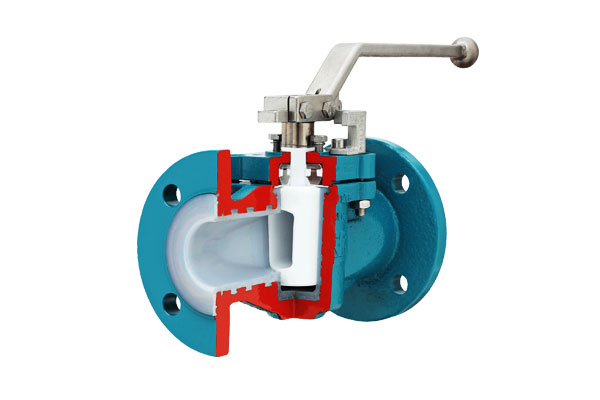
Ключ Кампаненты клапана
- Цела: Houses the plug and provides inlet/outlet connections (фланцавы, наразныя, or welded).
- Штэпсельная вілка: The rotating element, shaped either as a straight cylinder or a cone, containing the port(s).
- Сядзенні: Provide sealing between plug and body; can be metal-to-metal surfaces or resilient inserts (Ptfe, гума).
- Сцябло & Handle/Actuator: Transmits torque from the operator (lever, gearbox, pneumatic or electric actuator) to the plug.
Operating Principles
Rotary Flow Control
Plug valves operate by rotating the plug around its axis—requiring just a quarter turn for full open or full close.
This allows rapid actuation: typical manual operation takes less than one second, and automated pneumatic or electric actuators can complete the stroke in 0.5–2 seconds.
Seal Formation
- Metal‑to‑Metal Seals: The plug’s hardfaced surface (often coated with Stellite) directly contacts the body’s bore.
Under line pressure, the plug presses into the body, enhancing the seal.
These valves withstand temperatures up to 550 °C and high‑pressure applications (Клас ANSI 600 and above), but require higher break‑away torque (100–500 Nm for DN 50–200 valves). - Resilient (Soft) Сядзенні: Elastomeric or PTFE rings around the plug bore provide a conforming seal with minimal torque (10–50 Nm for DN 15–100 valves).
Soft‑seated plug valves achieve bubble‑tight shutoff per API 598 but are typically limited to temperatures below 200 °C and pressures under ANSI Class 300.
Torque Requirements & Уклад
Torque to operate a plug valve depends on size, seat type, and service conditions. As a rule of thumb:
- Soft‑seated DN 50 valves require ~15 Nm to open; soft‑seated DN 200 valves up to 60 Нм.
- Metal‑seated DN 50 valves may need 100 Нм; metal‑seated DN 200 valves up to 400 Нм.
Manual Actuation: Lever or handwheel, often with a gearbox for larger valves.
Pneumatic Actuation: Double‑acting or spring‑return cylinders for rapid, reliable quarter‑turn operation—cycle times <1 s.
Electric Actuation: Offers precise position control and feedback for integration with DCS/SCADA systems; typical stroke times of 2–5 s.
3. Types and Basic Designs of Plug Valve
Plug valve is engineered in various configurations to meet a wide range of process requirements.
Key design distinctions are based on lubrication method, plug geometry, port configuration, and internal flow path.
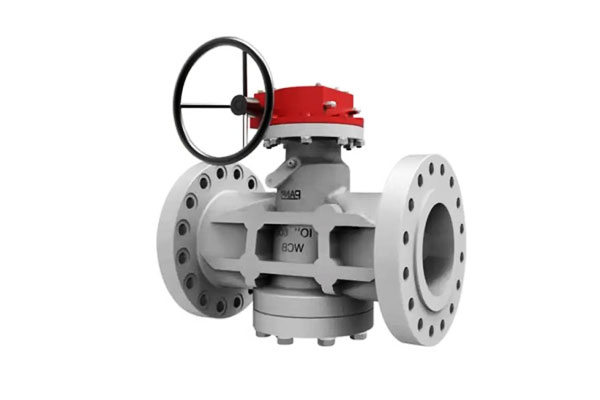
Lubricated vs. Non-Lubricated Plug Valves
- Lubricated Plug Valve
These valves rely on the injection of a sealant—typically a graphite- or PTFE-based compound—between the plug and the valve body.
The lubricant serves multiple roles: it reduces friction during operation, enhances sealing integrity, and provides a protective barrier against corrosive or abrasive media. - Non-Lubricated Plug Valve
These designs use self-lubricating materials—such as PTFE (Политетрафторэтилен) with glass fiber reinforcement—for the seat or employ hard-coated plugs (e.g., electroless nickel or hard chrome coatings with surface hardness > 60 HRC) to minimize friction.
Plug Configurations: Cylindrical, Conical & На цапфах
- Conical (Tapered) Штэпсельная вілка
Featuring a taper that matches the valve body’s seat angle, conical plugs are self-aligning under line pressure, providing a more secure and leak-tight seal.
They are especially effective in high-pressure applications (≥2,500 psi / 172 забараняць). - Cylindrical Plug
These plugs have parallel sides and rely on spring-loaded seats or resilient inserts to maintain contact.
Cylindrical configurations are better suited for low to moderate pressure systems and are often used in compact or low-cost valve designs. - Trunnion-Mounted Plug
In this design, the plug is guided by upper and lower trunnions, which reduce torque requirements and wear on sealing surfaces.
This structure is preferred for large-diameter valves (≥12″) or extremely high-pressure applications (да 15,000 PSI / 1,034 забараняць), such as subsea or high-integrity pressure protection systems (HIPPS).
Multi-Port Plug Valve
- Three-Way Plug Valve
Designed with L-shaped or T-shaped plug passages to divert flow between three ports.
Common in mixing, bypassing, or diverting services (e.g., blending hot and cold water streams, sampling systems, or line switching). - Four-Way Plug Valve
Include cross-shaped or double-L internal passages to reroute flow between two inlet-outlet pairs.
These are widely used in batch chemical operations and reactor feed alternation, allowing complex process sequences with minimal valve count.
Port Size Configurations: Full-Port vs. Reduced-Port
- Full-Port Plug Valve
The internal flow passage matches the diameter of the connecting pipeline (e.g., a 2-inch valve has a 2-inch port).
This design minimizes pressure drop and is essential where flow efficiency or pigging is critical.
Typical Cv for 2″ full-port plug valve: ~50. - Reduced-Port Plug Valve
The flow path is one nominal pipe size smaller than the inlet/outlet connections (e.g., a 2-inch valve with a 1.5-inch bore).
This design reduces material and manufacturing costs but introduces a higher pressure drop.
Typical Cv for 2″ reduced-port valve: ~30.
4. Materials and Construction of Plug Valve
The material selection and construction of a plug valve are critical to its performance, моцнасць, and chemical compatibility in demanding industrial environments.
Each component—the body, штэпсельная вілка, сядзенні, and internal seals—is engineered using materials tailored to withstand specific pressures, тэмпература, and process media.

Цела & Plug Materials
| Матэрыял | Standard/Grade | Ключавыя ўласцівасці | Тыповыя прыкладанні |
| Чыгун | ASTM A126 Class B | Эканамічны, suitable for low-pressure systems; limited corrosion resistance | Water supply, ВВК, municipal systems |
| Вугляродная сталь | ASTM A216 WCB | High mechanical strength; suitable for medium-high pressure/temperature | Змазваць & бензін, пара, petrochemical pipelines |
| З нержавеючай сталі | ASTM A351 CF8/CF8M (316Ss) | Выдатная каразійная ўстойлівасць, especially against chlorides and acids | Chemical plants, food/pharma, марскія ўмовы |
| Нікелевыя сплавы | Hastelloy C-276, Умова 625, Манель 400 | Superior resistance to aggressive chemicals and high temperatures | Acid handling, offshore, gas scrubbing |
| Пластычнае жалеза / Бронза | ASTM A536 / ASTM B62 | Good mechanical properties with cost-effectiveness | Сельская гаспадарка, Пітная вада, general plumbing |
Сядзенне & Liner Materials
| Матэрыял | Temp Range | Асноўныя функцыі | Recommended Services |
| Ptfe (Тэфлон) | –50°C to +230°C | Нізкае трэнне, excellent chemical inertness | Ежа, фармацэўтычны, corrosive chemical handling |
| Filled PTFE | –50°C to +260°C | Reinforced with glass or carbon for better wear and strength | High-cycle chemical systems |
| Эластамеры (EPDM, ФКМ) | –30°C to +200°C | Good sealing flexibility, resistant to water, паветра, and light hydrocarbons | Падрыхтоўка вады, ВВК |
| Flexible Graphite | –200°C to +540°C | High-temp resistance, fire-safe; used in critical sealing | Steam lines, НПЗ, high-temp pipelines |
| Метал да металу (Зорныя, Chrome-Plated) | Да 650 ° С | Hard sealing surface for erosive or abrasive fluids | Заторы, abrasive oils, fertilizer plants |
Змазкі (for Lubricated Plug Valves)
| Lubricant Type | Асноўныя характарыстыкі | Service Suitability |
| Graphite-Based Grease | High-temperature resistance, нізкае трэнне | Пара, heavy oil, refinery applications |
| Ptfe / MoS₂ Compounds | Low coefficient of friction, chemically inert | Corrosive gas, chemical feedlines |
| Silicone-Based Sealants | Neutral behavior, effective in a wide temperature range | Natural gas distribution, general service |
5. Performance Characteristics of Plug Valve
Plug valves are known for their simple operation, robust sealing, and bidirectional flow capabilities.
Аднак, their performance varies significantly based on design, Выбар матэрыялу, and service conditions.
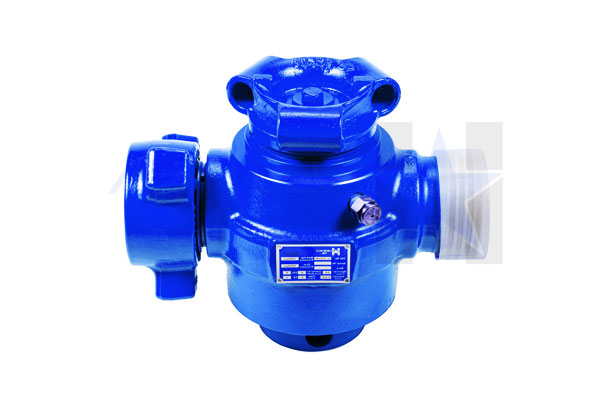
Pressure-Temperature Ratings
Plug valves are rated according to industry standards such as API 599 і ISO 17292, which define safe operating pressure limits at various temperatures.
These ratings depend heavily on the valve’s body material і Дызайн сядзення.
| Матэрыял | ASME Class | Максімальны ціск (psig) | Максімальная тэмпература (° С) |
| Вугляродная сталь (WCB) | 150 | ~285 @ 38°C | ~425°C |
| З нержавеючай сталі (Cf8m) | 300 | ~740 @ 38°C | ~540°C |
| Сплаў (Умова 625) | 600 | >1,480 @ 38°C | >650° С |
Seal Tightness & Leakage Classes
Plug valves, especially with soft seats or injected grease, can achieve bubble-tight shutoff. Leakage standards are tested per:
- API 598: Pressure test protocol for industrial valves
- ISO 5208: Valve leakage classification
- Leakage Class VI (мяккае сядзенне): Essentially zero visible leakage
- Leakage Class IV (metal seat): Acceptable for most industrial gas and liquid services
Lubricated plug valves rely on grease to maintain seal integrity and require periodic re-injection, прамежак часу non-lubricated versions use elastomer or PTFE sleeves that can wear over time.
Flow Characteristics (Cv Values)
Plug valves exhibit linear or equal-percent flow control behavior, depending on port geometry (round vs. rectangular or V-notch).
Though primarily used for isolation, some plug designs allow moderate throttling.
- Full-Port Plug Valve (2-inch):
-
- Cv ≈ 45–55 (high flow efficiency)
- Reduced-Port Plug Valve (2-inch):
-
- Cv ≈ 25–35 (higher pressure drop)
Рэзюмэ (Flow Coefficient) represents the flow rate in gallons/minute of water at 60°F that will flow through the valve with a 1 перапад ціску на квадратны дюйм.
Torque Requirements & Уклад
Plug valves typically require higher operating torque than ball or butterfly valves due to larger contact areas between the plug and seat.
| Тып клапана | Typical Torque (Nm for 2″ Valve) |
| Lubricated Plug Valve | ~50–100 Nm (depends on lubricant film) |
| PTFE-Lined Plug Valve | ~30–60 Nm |
| Metal-Seated Plug | >100 Нм (requires gear or actuator) |
6. Application Fields of Plug Valves
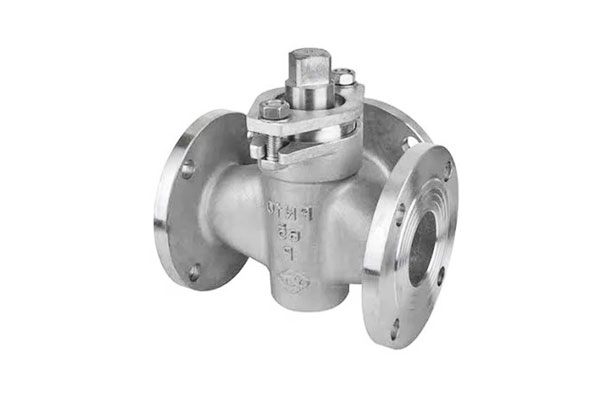
- Змазваць & Бензін (Upstream, Midstream, Downstream)
- Хімічны & Petrochemical Industry
- Вада & Wastewater Treatment
- Пакаленне электраэнергіі
- Шалона & Paper Industry
- Горная прамысловасць & Mineral Processing
- ВВК & Building Services
- Ежа & Індустрыя напояў
- Марская & Offshore Engineering
- Фармацэўтычны & Biotech Industry
- СПГ & Cryogenic Systems
- Сталь & Metallurgical Plants
- Refining & Bulk Storage Terminals
- Textile & Dyeing Industry
- Сістэмы супрацьпажарнай абароны
7. Advantages and Limitations of Plug Valve
Advantages of Plug Valve
- Simple Design: Minimal internal components, making maintenance straightforward.
- Quick Operation: 90-degree quarter-turn allows fast open/close action.
- Tight Shutoff: Excellent sealing capability, especially with resilient seats or lubricant.
- Двухнакіраванае ўшчыльненне: Seals effectively in both flow directions.
- Compact Size: Short face-to-face dimensions compared to gate or globe valves.
- Multi-Port Options: Available in 3-way or 4-way configurations for flow diversion or mixing.
- Высокая трываласць: Suitable for abrasive, corrosive, or slurry media (with appropriate materials).
- In-Line Maintenance: Many designs allow servicing without removing the valve from the pipeline.
Limitations of Plug Valve
- High Operating Torque: Especially in metal-seated or larger valves; may require gear or actuator.
- Friction Wear: Metal-to-metal designs can experience galling and wear over time.
- Lubrication Needs: Lubricated plug valve require periodic re-greasing to maintain sealing and ease of operation.
- Каштаваць: Can be more expensive than ball valves in similar pressure/temperature ranges.
- Limited Throttling: Not ideal for precise flow control due to potential erosion and wear in partially open positions.
- Абмежаванні памеру: Less common in sizes above 24 inches due to torque and manufacturing limits.
8. Параўнанне: Plug Valve vs. Мяч, Брама, and Butterfly Valves
| Аспект | Запорны клапан | Шарыкавы клапан | Засаўка | Клапан матылькоў |
| Задума | Simple body and tapered/cylindrical plug | Rotating spherical ball with bore | Rising wedge or parallel gate disc | Disc rotates on a central shaft |
| Аперацыя | 90° quarter-turn | 90° quarter-turn | Шматабаротныя (slow) | 90° quarter-turn |
| Магчымасць герметызацыі | Выдатны (especially lubricated types) | Вельмі добра (Шчыльнае адключэнне) | Добры (metal-to-metal contact) | Ад сярэдняга да добрага (depends on seat design) |
| Дросселирование | Абмежаваны, not recommended | Абмежаваны (not ideal for throttling) | Acceptable for minimal control | Fair to good control depending on design |
| Torque Requirements | Высокі, especially for larger valves | Умераны | Low to high (depending on pressure/size) | Нізкі да ўмеранага |
| Падтрыманне | Умераны (lubrication required for some types) | Нізкі (мінімальнае абслугоўванне) | Высокі (seat wear, stem packing) | Нізкі да ўмеранага |
| Suitability for Slurry/Abrasive Media | Добры (especially with metal seats) | Бедны (may clog or erode ball seat) | Кірмаш | Fair to good with suitable disc materials |
| Multi-Port Options | Так (3-way, 4-way) | Так (limited 3-way availability) | Ніякі | Ніякі |
| Падзенне ціску | Нізкі да ўмеранага (depends on port size) | Нізкі (full bore design) | Нізкі | Умераны |
| Space Requirement | Compact face-to-face, larger actuator for torque | Кампактны | Long face-to-face (vertical space needed) | Very compact |
| Каштаваць | Умераны да высокага (especially metal-seated) | Умераны | Нізкі да ўмеранага | Нізкі да ўмеранага |
| Прыкладанне | Хімічны, змазваць & бензін, slurry, multi-directional flows | General use, вада, змазваць & бензін, shutoff | Waterworks, isolation, non-frequent operation | ВВК, вада, low-pressure gas, large pipe diameters |
Summary:
- Use Plug Valves when you need tight shutoff, bidirectional sealing, or multi-port flow in tough services like slurries or chemicals.
- Шарычныя клапаны are ideal for fast shutoff and minimal pressure drop in clean media applications.
- Gate Valves suit infrequent isolation in large-bore systems.
- Паваротныя клапаны excel in space-limited, low-pressure environments with large diameters.
9. Sizing, Selection & Installation Guidelines
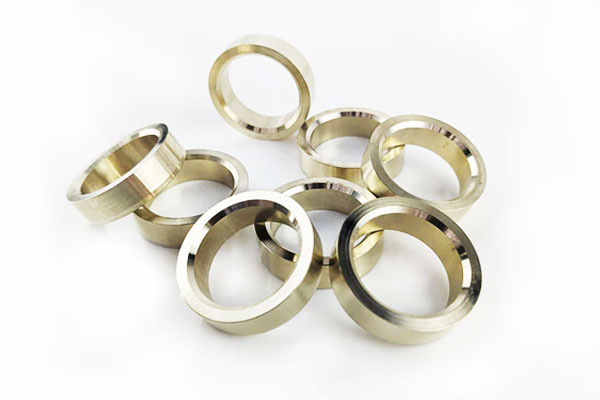
- Media and Conditions: Match body and seat materials to fluid chemistry, тэмпература, і ціск.
- Sizing: Use Cv calculations to ensure required flow at expected ΔP; select actuators to deliver 1.5× break‑away torque.
- Installation: Orient plug vertically in lubricated valves to prevent grease pooling; maintain 1× valve length of straight pipe on each side for optimal performance.
10. Падтрыманне, Inspection & Ліквідацыю непаладак
- Змазка: Every 6–12 months or 5,000 цыклы; use manufacturer‑approved grease.
- Seat Replacement: In many designs, seats can be changed in-line without body removal.
- Агульныя праблемы: Galling on metal seats remedied by relubrication; graphite packing leaks corrected by repacking; plug erosion addressed by Stellite overlays or seat refurbishment.
11. Стандарты, Certifications & Тэставанне
- API 599: Inspection and test procedures.
- ISO 17292: Performance requirements for plug, мяч, and butterfly valves.
- MSS SP‑79/SP‑80: Guidelines for lubricated and non‑lubricated plug valves.
- Certifications: API Monogram, CE marking, SIL ratings for safety instrumented systems.
12. Conclusion
Plug valves offer a unique blend of simplicity, хуткасць, і універсальнасць across a diverse array of process industries.
By carefully selecting body, штэпсельная вілка, and seat materials—and by adhering to best practices in sizing, ўстаноўка, and maintenance—engineers can leverage plug valves for reliable isolation, diversion, and rudimentary flow control in virtually any fluid service.
Гэтае: Высокадакладныя рашэнні для ліцця арматуры для патрабавальных прыкладанняў
Гэтае з'яўляецца спецыялізаваным пастаўшчыком паслуг дакладнага ліцця арматуры, пастаўка высокапрадукцыйных кампанентаў для галін, якія патрабуюць надзейнасці, цэласнасць ціску, і дакладнасць памераў.
Ад неапрацаваных адлівак да цалкам апрацаваных корпусаў клапанаў і вузлоў, Гэтае прапануе скразныя рашэнні, распрацаваныя ў адпаведнасці са строгімі сусветнымі стандартамі.

Наш вопыт ліцця клапанаў уключае:
Інвестыцыйнае ліццё для корпусаў клапанаў & Аздабленне
Выкарыстанне тэхналогіі ліцця па выпушчаным воску для вытворчасці складанай унутранай геаметрыі і кампанентаў клапана з жорсткім допускам з выключнай аздабленнем паверхні.
Пясчанае ліццё & Ракавіна ліцця цвілі
Ідэальна падыходзіць для сярэдніх і вялікіх корпусаў клапанаў, фланцы, і капоты, якія прапануюць эканамічна эфектыўнае рашэнне для надзейных прамысловых прымянення, уключаючы алей & вытворчасць газу і электраэнергіі.
Дакладная апрацоўка для ўстаноўкі клапана & Цэласнасць пячаткі
Апрацоўка з ЧПУ месцаў, ніткі, і ўшчыльняльныя паверхні гарантуюць, што кожная літая частка адпавядае патрабаванням да памераў і ўшчыльнення.
Дыяпазон матэрыялаў для найважнейшых прымянення
З нержавеючай сталі (CF8/CF8M/CF3/CF3M), мосенж, пластычнае жалеза, да дуплексных і высоколегированных матэрыялаў, Гэтае пастаўляе адліўкі клапанаў, створаныя для працы ва ўмовах каразіі, высокага ціску, або высокатэмпературныя асяроддзі.
Незалежна ад таго, ці патрэбныя вам спецыяльна распрацаваныя рэгулюючыя клапаны, коркавыя клапаны, Глобусныя клапаны, засаўкі, або буйнасерыйная вытворчасць прамысловага ліцця арматуры, DEZE is your trusted partner для дакладнасці, моцнасць, і забеспячэнне якасці.
FAQ
When should I choose a plug valve over a ball valve?
Выбірайце коркавыя клапаны in high‑temperature or abrasive services, or where simple quarter-turn, bidirectional operation is needed.
How often should a lubricated plug valve be re-lubricated?
Typically every 6–12 months or after 5,000–10,000 cycles, depending on service severity.
Can plug valves be used for throttling service?
Limited throttling is possible with equal‑percent plugs, but seat wear increases; globe valves excel at precise flow control.
What causes plug valve leakage and how is it fixed?
Wear or damage to seats and plugs leads to leakage; remedy via seat replacement, plug re-lapping, or re-lubrication for metal‑to‑metal valves.



